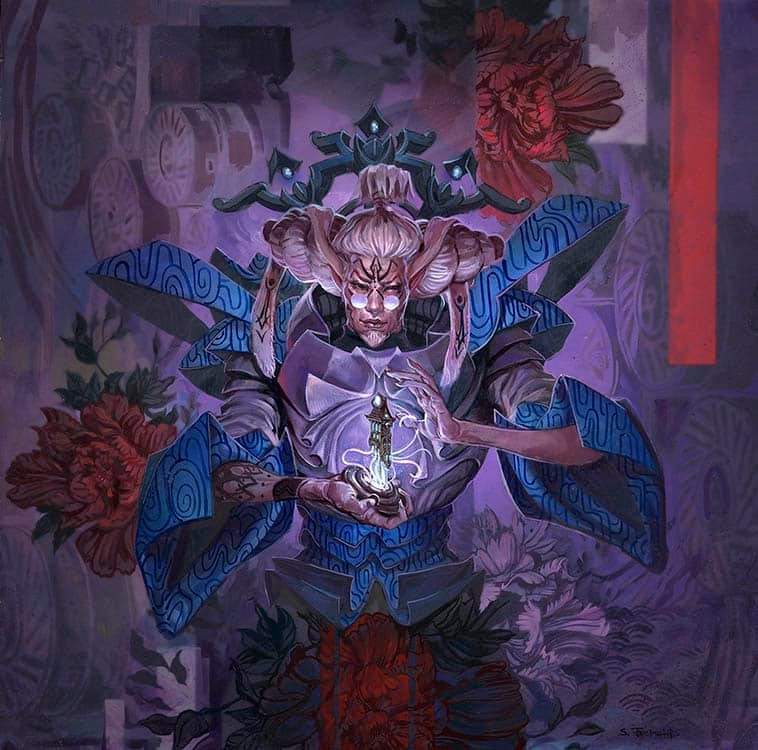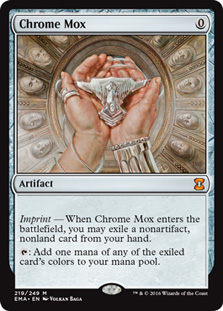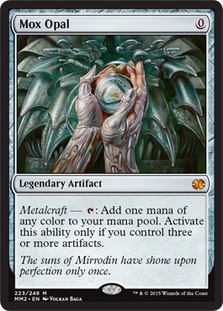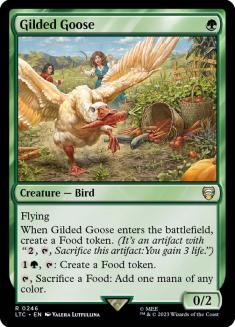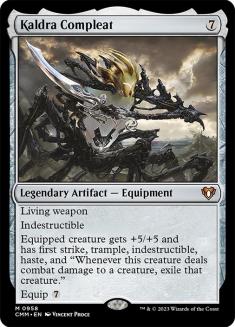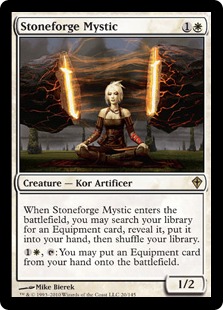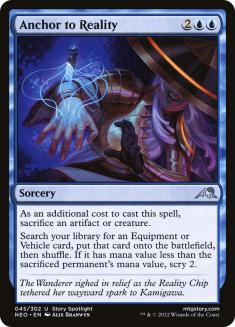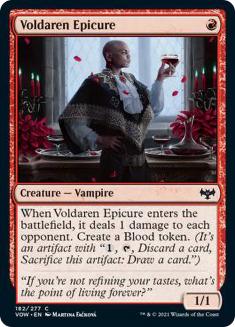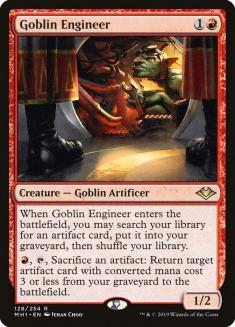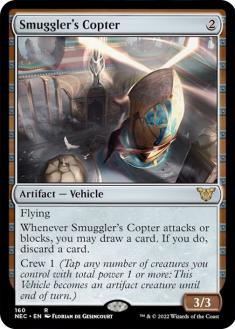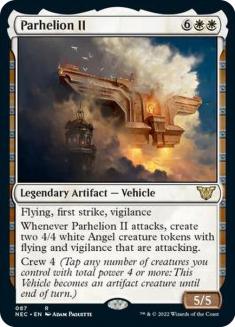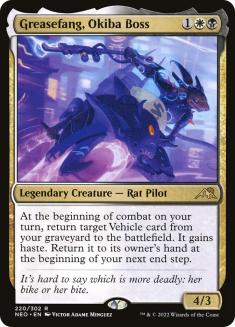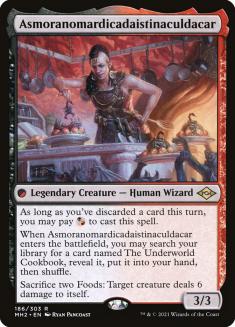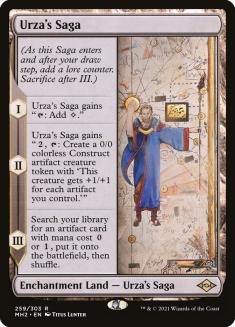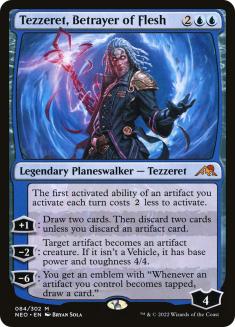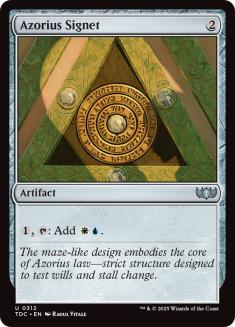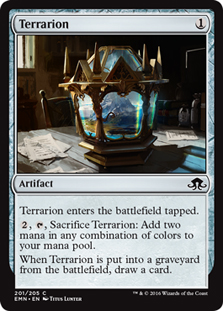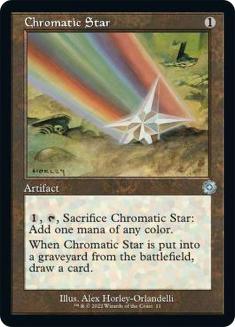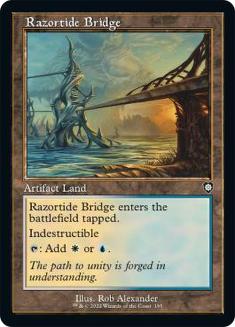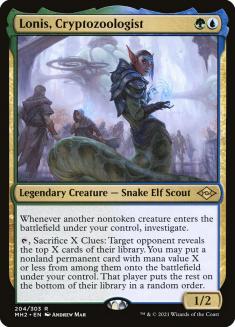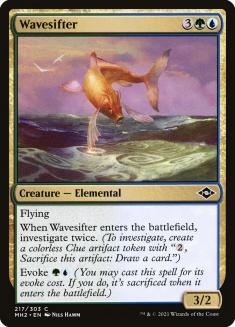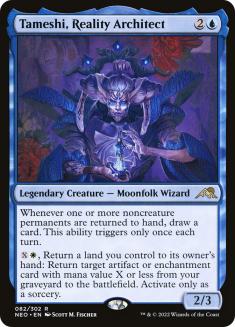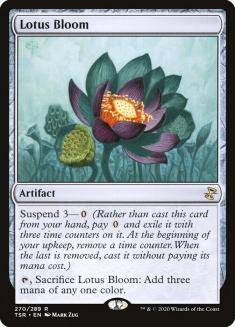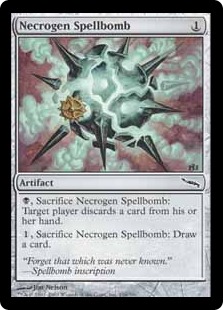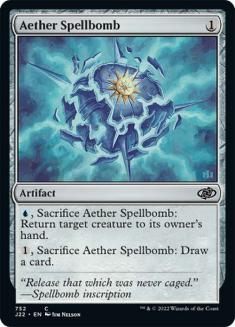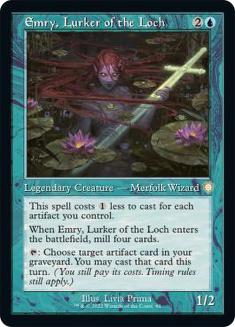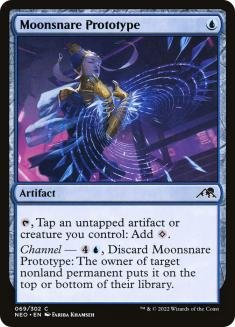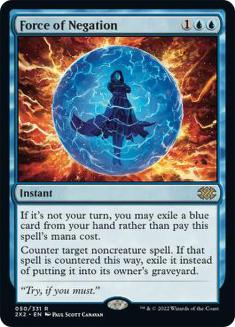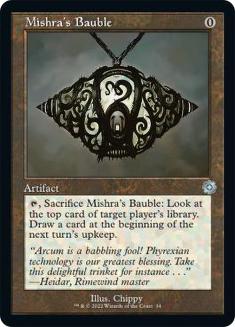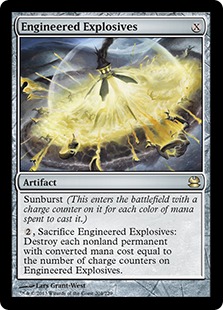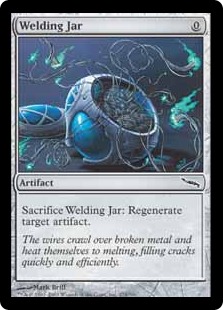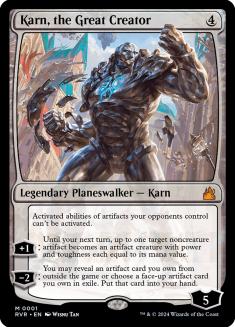Kamigawa: Neon Dynasty is more of an artifact set than Kaladesh was, and in terms of exciting Modern playables, it has quite the list to offer for a Standard set release.
All these new cards sit on top of the foundation laid by twenty years of sets. Modern started with Mirrodin block, still the wildest artifact sets in the format. Which of these old Modern artifact-centric cards should you have at the ready for Kamigawa’s latest spice?
Dishonorable Mention: Kaldra Compleat and Stoneforge Mystic
Honorable mentions are overrated. Just add more slots to your list. No one is forcing you to have a round number. It’s time to be a hater and kick off with the package that’s going to fall flat on its face in Modern.
Anything that looks like Tinker deserves a Scryfall search for what it can find in Modern, and the absolute best thing around is Kaldra Compleat. Putting a Kaldra Compleat in your deck is already subsidized by Stoneforge Mystic, so it almost looks like you can build a deck that reliably makes the biggest living weapon in town.
I just don’t think that’s good.
You’re paying four mana and an artifact for a 5/5 stack of abilities. Is that even better than Urza, Lord High Artificer or any other four-drop you can cast in these themes? I doubt it.
Maybe you see one Anchor to Reality in the Azorius Urza (Yorion) decks that already had Stoneforge Mystic and just wanted another low-effort whammy in their 80 cards. But you will probably have to wait until they print some silly Vehicle in Modern Horizons 7 to make Anchor to Reality a dedicated plan for a deck.
5. Voldaren Epicure, Goblin Engineer, and Smuggler’s Copter
Maybe I’m burying the lede here, but for this first package, I think it’s more important to highlight the enablers than the engine itself.
The big finish I’m alluding to is Greasefang, Okiba Boss recurring and crewing Parhelion II for thirteen power of flying attackers. It isn’t a full kill, but it’s pretty darn close. Greasefang is even a modest beater itself when the combo isn’t assembled, so your bad card density is minimized and you can largely build a functional deck that has this powerful combo to steal wins.
You just need to get Parhelion II into the graveyard and have it do something when you don’t draw Greasefang. Any good Looting effect covers both of those parts, and Goblin Engineer is the flexibly functional Entomb you want (and need, since Unmarked Grave can’t find legendary permanents).
Where Voldaren Epicure comes in is tying the room together between multiple powerful plans. My experiments with Rakdos Vampries late last year really showed me how the issue with the Urza’s Saga plus Asmor decks early in the Modern Horizons 2 format was leaning too hard on those cards as primary plans. When you just did other stuff but had those to hammer home good exchanges and wins, everything just felt smoother. The recent success of Crack the Earth is another application of this principle, minus the Asmor.
Greasefang is your powerful main plan. You get to build a deck that’s operating in a similar space to Orzhov Hammer (Lurrus), but with better card velocity and more interaction instead of the perfect fast kills.
Creatures (19)
- 4 Bloodghast
- 3 Goblin Engineer
- 4 Asmoranomardicadaistinaculdacar
- 4 Voldaren Epicure
- 4 Greasefang, Okiba Boss
Lands (23)
Spells (18)

4. Azorius Signet, Terrarion, and Chromatic Star
Tezzeret, Betrayer of Flesh is yet another card that deserves a whole Scryfall search due to its static ability. As a standalone planeswalker, it’s fairly powerful, but not a must-play. The [+1] is a lot of cardboard moving around, but we aren’t in an era of four-drops that just move cardboard being enough. The [-2] is a solid threat, but it’s comparable to Tezzeret, Agent of Bolas, so we’re just getting into a color-shifting argument.
But the cost reduction is a big deal. Getting mana back on casting your big threat lets you do more stuff, and doing more stuff is how you win games. The once-a-turn cap prevents this from being a combo card, but the lack of the more traditional minimum cost of one cap means you can just freely take another game action on-curve with Tezzeret.
Sadly, the big search of activated abilities came up a bit short on really cool stuff to do, but I’m fine just laundering the Tezzeret ability into real mana. Azorius Signet is the more permanent way to do this, but I’m partial to the maximum value of Terrarion or the more measured Chromatic Star.
A bit of this bias towards the one-shot artifacts is a tiny clause on Tezzeret: “the first.” Any artifact activated ability you use prior to casting Tezzeret expends the future use of the cost reduction, and that includes simple mana abilities. As much as your first instinct is to pair Tezzeret with artifact lands and mana rocks, you may want to think a bit about how you allocate those cards in your deckbuilding if you want to really maximize his best ability.
The other option for Tezzeret is to pump the static ability’s fake mana into Clue or Food tokens. This makes the best use of the “each turn” clause on Tezzeret since it’s easy to end up with a surplus of tokens to activate on your turn and your opponent’s turn. I’m unsure what else you do with your lifetime supply of Clues and cards, but you do get to do a lot of it.
3. Lotus Bloom and Aether Spellbomb
Tameshi, Reality Architect is my pet card of the set. It feels like a combo engine for the modern Modern era. It’s efficient to land when speed is needed, it provides significant immediate value against interaction, it meshes well with other good cards, and it has a simple plan to go big and send your opponent packing.
That plan is looping through your lands to recur Lotus Bloom. I haven’t figured out what you’re supposed to do after all your lands bounce to make three mana each, but it seems easy enough to get to a win somehow from there.
Assuming some of this involves drawing most of your deck, there are some low-deckbuilding-impact ways to go truly infinite with Tameshi. The baseline I’ve found so far is returning an artifact land to your hand with its ability, getting back a different artifact land, and discarding the first artifact land for benefit to get back where you started. There’s just a quick step of laundering your artifact land mana to white, which might require something weird like Amulet of Vigor untapping Razortide Bridge, but this is all just a means to an end once you have unraveled most of your cards.
Or maybe you skip this all and go for a more archaic draw-step Necrogen Spellbomb lock, since Tameshi can chain off a bunch of activations to start. This is even a fine thing to churn your Lotus Bloom mana into, since emptying their hand with multiple prior Spellbomb activations is a key part of starting the draw-step lock.
Much more obvious are the excellent fair applications of Tameshi.
Tameshi triggers on any permanent being returned to hand each turn. Normally the sorcery-speed restriction on the recursion ability limits that to just your turn, but if you’re looping Aether Spellbomb or Seal of Removal, you get a double card cycle at land parity. You can also just use these cards to protect your Tameshi from opposing interaction.
Or you can pair Tameshi with Urza’s Saga in a lot of great ways. If they kill your Urza’s Saga, Tameshi recurs it. If you want to aggressively use Urza’s Saga for a tutor, Tameshi recurs it. And if you just want to extend the number of Constructs you make, Tameshi picks up Saga with Chapter III on the stack or recurs it. It’s hard to say to watch for more Urza’s Saga when it’s already one of the five best cards in the format, but ya know, watch for more Urza’s Saga.
Just think of Tameshi like Emry, Lurker of the Loch, but for a bit more mana, you actually get somewhere by activating the card. The impact of an Emry tap has always been the problem with the card in the post-Mox Opal era, and Tameshi’s card draw and broader set of recursion options solve that and then some.
2. Mishra’s Bauble, Engineered Explosives, and Welding Jar
Moonsnare Prototype looks like an extra set of Springleaf Drums at first glance, but it is so much more than that. Two weeks ago on Dominaria’s Judgment, Dom and I were definitely stuck in the former rut, but this last week I think we broke through and saw the card for the Modern-changing potential it has.
The small piece I came to the discussion with is that Moonsnare Prototype is blue. Artifact decks have found success in Legacy the last few months by becoming blue decks with Force of Will, and Moonsnare Prototype helps further solve the artifact-blue spell count conundrum for Force of Negation in Modern. Even if you aren’t starting the free counterspell, a broad-scope anti-combo or planeswalker card in the sideboard of your Thought Monitor or Urza, Lord High Artificer deck is a big boost (as is not having to pitch those high-impact cards to Force).
Sure, you might have a tutor toolbox that finds a specific hate card, but the snowballing nature of many other artifact decks means that turn Force of Negation buys you can translate to you comboing over your Goblin Charbelcher opponent. You can also do a bit of the Violent Outburst thing and Whir of Invention on their turn with Force of Negation backup.
The piece Dom latched onto, and probably the more important one, is that Moonsnare Prototype is a Springleaf Drum that lets you cast anything other than stupid Memnite. The best curves in Springleaf Drum decks involve a zero-drop creature plus Drum on Turn 1 into another play and three mana on Turn 2, but those draws also involve Memnite, which is definitely fractional cardboard. The zero-drop noncreature artifacts are miles ahead of the creature offerings, and Moonsnare Prototype lets you tap those to get the ball rolling.
Maybe a little mana boost means it’s time to change my opinion on Urza, Lord High Artificer plus Urza’s Saga in 60-card decks…
Creatures (10)
Lands (18)
Spells (32)

1. Karn, the Great Creator
Well, that’s an awfully rude way to end a list of artifact packages to watch.
Karn, the Great Creator is very good against a lot of the things I’ve walked through today. The release of Kamigawa: Neon Dynasty will likely to lead to an uptick in that card’s presence in decks like Amulet Titan where it’s a flex-slot threat.
But the exact same thing can be said in the reverse. All of these artifact packages are a bit mana-intensive and looking for big-play backup plans for when the full synergy setup doesn’t work. Why shouldn’t that just be Karn, the Great Creator?
Need to tutor for a combo piece, or just get that garbage kill condition out of your 60 drawable cards? Need to win a pseudo-mirror? Or do you need the right hate card against a more linear, less resilient deck? Karn has you covered.
What does Karn ask for? Mana acceleration so you can land a four-drop planeswalker that needs a turn of setup sounds like Moonsnare Prototype or Azorius Signet’s job. Or maybe dorky chump blockers like Voldaren Epicure or Sai, Master Thopterist tokens, all of which double as ways to pressure down opposing Karns and open your gameplan back up.
I’m unsure if Karn is the best or worst thing to happen to all the artifact decks bound to explode out of Kamigawa: Neon Dynasty, but either way, it’ll be the most important card to be ready to build with as the format reacts to a dynamo of a set.

